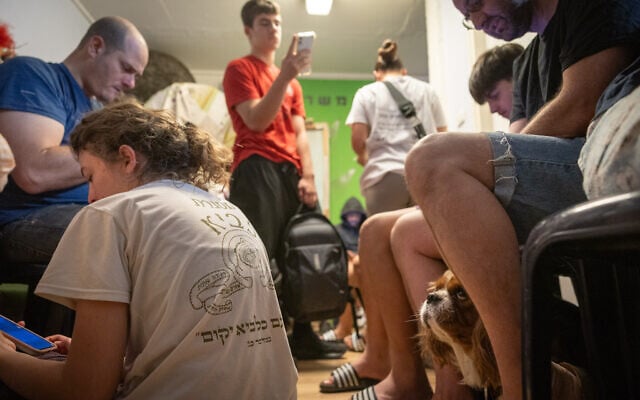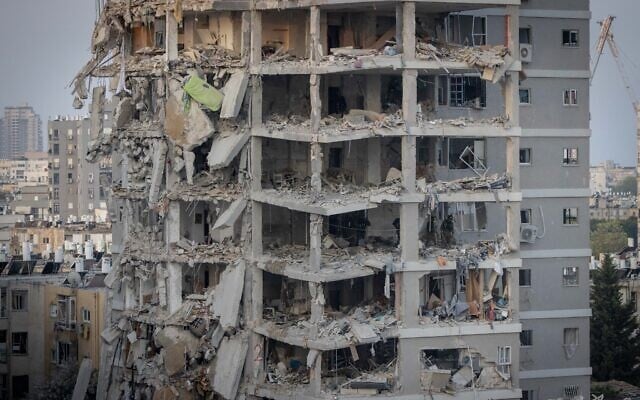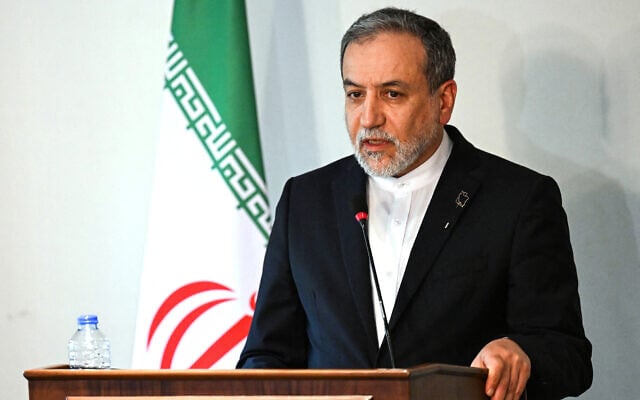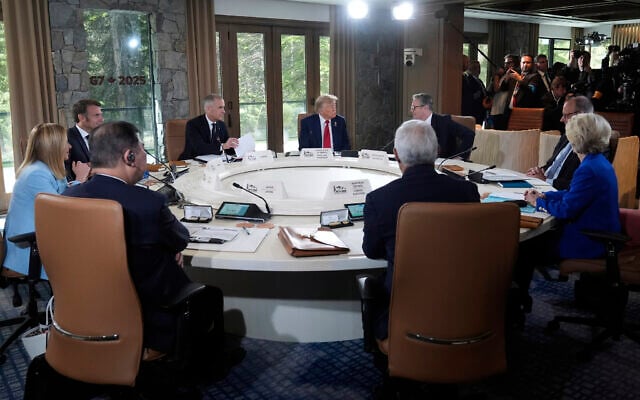Iranian missiles impact central Israel in morning barrage, injuring 5
Iran fired a barrage of missiles at Israel on Tuesday morning, some of which slammed into central areas of the country, including the city of Herzliya, causing a few light injuries.
Some 20 ballistic missiles were launched at Israel in Iran’s attack, according to initial Israel Defense Forces assessments.
It came as Iran appeared to signal it was interested in a negotiated ceasefire and as US President Donald Trump was set to hold a top-tier security meeting in Washington about the situation.
The Iranian attack set off air raid sirens across large swaths of the country, from the north down to areas of the Negev in the south. Sirens were triggered in the Jerusalem area, although not in the capital itself, where explosions from air defense interceptors were heard.
Police in central Israel said officials were dealing with three impact sites, and reported that there was some material damage.
Get The Times of Israel's Daily Edition by email and never miss our top stories
By signing up, you agree to the terms
“Our focus now is on making sure there are no sites or incidents or injuries that we do not yet know about,” Yarkon District head Tzachi Sharabi told reporters.
The aftermath of an Iranian missile strike seen in central Israel, June 17, 2025. (Eli Katzoff)
Reports indicated that one missile hit a storage shed near Herzliya, setting it on fire, and another hit a parking lot, where an empty bus went up in flames.
MDA reported that five people were lightly injured in that incident. Firefighters rushed to the scene and worked to extinguish the blaze.
There were also scattered reports of damage from falling shrapnel.
In addition, the military said it shot down a drone that was launched at Israel, apparently from Iran. The attack sounded sirens in Ramat Magshimim in the Golan Heights.
The Israeli Air Force also shot down some 30 drones launched at Israel overnight, all apparently from Iran, the military said. Many of the drones were intercepted beyond Israel’s borders. Several were shot down over the Golan Heights, according to the military.
The military released footage of one of the interceptions by an IAF helicopter.
The morning attacks came after fewer than 10 ballistic missiles were launched from Iran at Israel overnight, according to IDF assessments.
The missiles came in three overnight attacks targeting central and northern Israel: just after midnight, then at 3:30 a.m. and 4:30 a.m.
The IDF said its air defenses acted to intercept the missiles. There were no reports of impacts in urban areas or injuries.
People take cover in a public shelter in Jerusalem following a warning of a possible missile attack, June 17, 2025. (Noam Revkin Fenton/Flash90)
The Home Front Command gave much shorter early warnings for Iran’s overnight ballistic missile attacks than it had previously.
In the attacks that occurred just after midnight, at 3:30 a.m., and 4:30 a.m., Home Front Command issued an alert to civilians’ phones just 2-3 minutes before the actual sirens sounded. Normally, the IDF issues the early warning around 10 minutes before sirens sound, as missiles are detected being launched.
Additionally, Home Front Command did not issue a pre-launch alert calling on civilians in areas potentially under threat to be prepared to head to a bomb shelter in any of the overnight attacks. The Home Front Command has said it seeks to issue this alert 15-30 minutes before an attack is launched.
The shorter early warning and lack of preliminary alert were thought to be tied to the fact that Iran launched far fewer missiles in the overnight salvos than it had done previously, with fewer than 10 in each of the three attacks. When Iran’s missile barrages comprise dozens of missiles, it is believed to be easier for the military to detect the preparations and the launch ahead of time.
Eight people were killed Monday after impacts in Petah Tikva, Haifa, and Bnei Brak, and a day earlier, nine people were killed in Bat Yam and four in Tamra.
Taking the offensive, the air force carried out several waves of strikes in western Iran, destroying anti-aircraft launchers, ballistic missile launchers, and drones, the IDF said. Later on Tuesday morning, the IDF said that it had killed senior Iranian general Maj. Gen. Ali Shadmani in a strike on Tehran.
The scene of an apartment building destroyed by an Iranian ballistic missile impact, in Bat Yam, June 15, 2025. (Chaim Goldberg/Flash90)
Israel says its sweeping assault on Iran’s top military leaders, nuclear scientists, uranium enrichment sites, and ballistic missile program is necessary to prevent its longtime adversary from getting any closer to building an atomic weapon. At the beginning the campaign last Friday, it said the situation had become an immediate existential threat to the Jewish state.
Iran has retaliated by launching more than 370 missiles and hundreds of drones at Israel. So far, 24 people have been killed in Israel and more than 500 wounded.
Israeli strikes on Iran have killed at least 224 people, according to Iranian officials.
Iran indicates it’s seeking diplomatic end
The exchanges came as Iran indicated it was open to ending the conflict via diplomacy and as world leaders meeting at the Group of Seven summit in Canada called for a de-escalation of the worst-ever conflict between the regional foes, while stressing that Iran must never have a nuclear weapon and affirming Israel’s right to defend itself.
Sources told Reuters that Tehran had asked Oman, Qatar, and Saudi Arabia to urge Trump to pressure Israeli Prime Minister Benjamin Netanyahu to agree to an immediate ceasefire. In return, Iran would show flexibility in nuclear negotiations, according to two Iranian and three regional sources.
Iranian Foreign Minister Abbas Araghchi speaks during a joint press conference with his Egyptian counterpart after their meeting in Cairo, Egypt, on June 2, 2025. (AFP)
Iran’s foreign minister, Abbas Araghchi, appeared to make a veiled plea Monday for the US to step in and negotiate an end to hostilities.
“If President Trump is genuine about diplomacy and interested in stopping this war, next steps are consequential,” Araqchi said on X. “Israel must halt its aggression, and absent a total cessation of military aggression against us, our responses will continue.”
“It takes one phone call from Washington to muzzle someone like Netanyahu,” Iran’s top diplomat wrote. “That may pave the way for a return to diplomacy.”
On Sunday, Araghchi said that Iran would stop its strikes if Israel does the same.
But Israel was seen as unlikely to halt its so-far highly successful campaign without concrete Iranian concessions to dismantle its nuclear program.
The Axios outlet reported Monday that the White House was discussing with Iran the possibility of a meeting this week between US envoy Steve Witkoff and Araghchi. Reuters couldn’t immediately verify details of the Axios report.
The messages to Washington were sent as the latest talks between the US and Iran about its nuclear program were canceled over the weekend after Israel’s surprise bombardment.
Trump has consistently said the Israeli assault could end quickly if Iran agreed to US demands that it accept strict curbs on its nuclear program.
Italy’s Prime Minister Giorgia Meloni, from left, France’s President Emmanuel Macron, Canada’s Prime Minister Mark Carney, US President Donald Trump, Britain’s Prime Minister Keir Starmer and Germany’s Chancellor Friedrich Merz participate in a session of the G7 Summit, June 16, 2025, in Kananaskis, Canada. (AP/Mark Schiefelbein)
Despite publicly rejecting the idea that they wish to attain nuclear arms, Iran’s leaders, who are sworn to destroy Israel, have stockpiled uranium enriched to 60% — far beyond what is needed for civilian use and a short technical step from weapons-grade.
Before leaving the summit in Canada a day early, Trump joined the other leaders in a joint statement saying Iran “can never have a nuclear weapon” and calling for a “de-escalation of hostilities in the Middle East, including a ceasefire in Gaza.”
The White House explained that Trump’s departure was “because of what’s going on in the Middle East” and confirmed media reports that the president requested that the National Security Council be prepared in the Situation Room.
US Secretary of State Marco Rubio left the G7 Summit early and headed back to Washington, along with Trump, CBS News reported.
Trump later denied reports that the reason he left the summit was to work on a ceasefire between Israel and Iran, blaming French President Emmanuel Macron for the misconception in remarks he made to the media.
“Wrong! He has no idea why I am now on my way to Washington, but it certainly has nothing to do with a Cease Fire,” Trump writes in a post on his Truth Social platform.
The president did not say what he is in fact working on, but teased that it’s “much bigger than that.”
“Whether purposely or not, Emmanuel always gets it wrong,” Trump wrote. “Stay Tuned.”
Earlier, Macron told reporters that there “is indeed an offer to meet and exchange. An offer was made, especially to get a ceasefire and to then kickstart broader discussions. We have to see now whether the sides will follow.”



